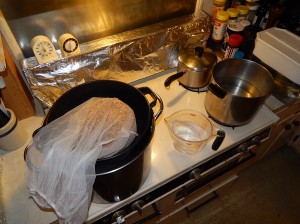
Brewing beer on your stovetop is convenient — and you can yield over 5 gallons (19 L) of beer in some circumstances.
This is the second part of an article on yielding 10 gallons (38 L) of beer from a stovetop wort boil. The first part dealt with the wort density during the boil and bitterness.
Color
When you boil a dense wort, the amount of ingredients alone will make it darker than many pale beers — deep golden at a minimum, if it is an all-malt beer. However, darker worts also pick up more color during the boil. There’s no way (that I know of) to calculate how much color will develop. However, if you were trying to brew a pale beer by boiling a very dense wort and diluting it, it would likely turn out too dark. This would also limit the number of BJCP styles that could be brewed with this level of dilution in the fermenter. At a minimum, I assume that the beer would turn out a light amber (although I haven’t tested this). So to be safe, we’ll only consider beers that are amber or darker.
Possible Styles
If our criteria is low gravity, low bitterness and amber or darker, the most tempting BJCP styles to brew would be Scottish 60/- or 70/- ale; British ordinary bitter, mild ale or Northern brown ale; or Irish dry stout. If you like German or Austrian beers, you could maybe try a dunkelweizen or Vienna lager. If you don’t pay attention to styles and just brew what you’d like, any beer under OG 1.045, 25 IBUs and amber or darker could be attempted, if you boil 3.5 gallons (13 L) of wort. For other boil volumes, see the chart from the first half of the article.
I’ll post an example recipe, but keep in mind that I haven’t tried this. I’ve tried all the components of this — boiled high-gravity worts, diluted beers to working strength in the fermenter, etc. — but never all together in one beer. I’ll try this soon. Until then I’ll just mark the recipe as something that should work, but only to try if you’re willing to accept a little risk. (I think the worse that would happen is that the beer would turn out a little darker and little less bitter than expected.)
It’s also possible that I’m being too conservative and you could push the limits farther and still yield acceptable beer. That will have to be determined by trial and error.
Brewing Tips
When attempting a large dilution, boiling a larger volume would be a good thing. This will require less of a dilution and will likely result in beer that could be more bitter and more pale, if desired. However, do not try to boil so large a volume that you cannot maintain a vigorous boil. A decent boil vigor is needed to adequately develop the hot break.
Most stovetop extract brewers add a portion of their malt extract late in the boil. Obviously, that would be a good thing in this instance. If you wanted, you could add only about one fifth or one forth of the malt extract and boil the wort at roughly your target OG. You could then add the rest near the end of the boil — or even in the whirlpool as long the temperature stays above 170 °F to sanitize the malt.
At a high wort density, you expect some color pickup during the boil. Don’t add to it by scorching blobs of undissolved extract at the bottom of your brewpot. Dissolve the malt extract in hot wort from your brewpot, then stir it back in when it is completely dissolved.
Finally, any volume of wort you lose to trub could potentially have been three to four times that volume of beer. Minimize the amount of “gunk” at the bottom of your kettle by using high alpha hops for bittering, if possible. If you don’t have a way to strain or filter your trub, let it settle for awhile after it has been cooled. This will let the trub compact and yield more wort. You can even save the trub in sanitized mason jars (or other containers). Store them in your fridge and the trub will compact overnight. You can then pour off the clear wort and add it to your fermenter.
Between 5 and 10 Gallons (19 and 38 L)
As you’ve probably thought by now, you could also boil a stovetop wort and dilute the beer to less than 10 gallons (38 L). This would yield less beer, but you could attempt stronger, more bitter and paler beers. If you’re going to try this, use the CV formula to calculate your boil gravity and required IBUs in the boiled wort from your target OG, IBUs and volume. From those numbers, see if your plan sounds reasonable. For example, using our same assumptions for not exceeding an SG 1.130 boil volume and assuming the maximum IBUs are 70, we could brew 8 gallons (30 L) of any amber or darker beer under 1.048 and 26 IBUs by boiling only 3 gallons (11) of wort. (And these rise to 1.057 and 31 IBUs if you increase the boil volume to 3.5 gallons (13 L). You can’t brew 10 gallons of IPA by boiling 2.5 gallons (9.5 L) of wort, but you could maybe brew 6 gallons (23 L) by boiling 4.5 gallons (17 L).
If you have some beers you brew frequently, consider if you could yield more in your fermenters with a greater rate of dilution of your stovetop wort.
Related articles
Increase your yield

Speak Your Mind